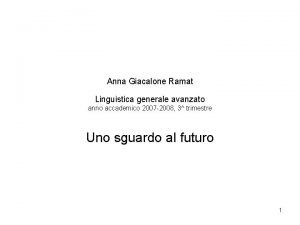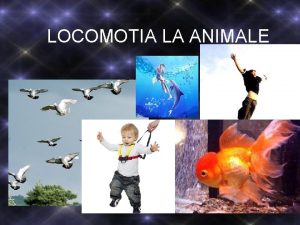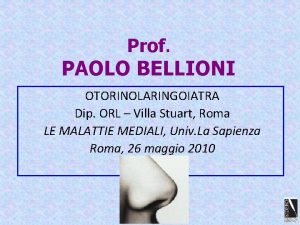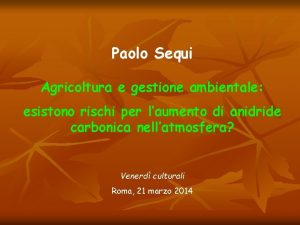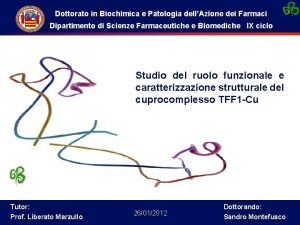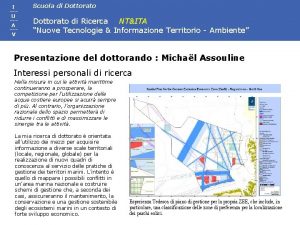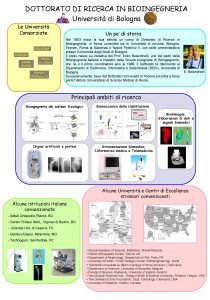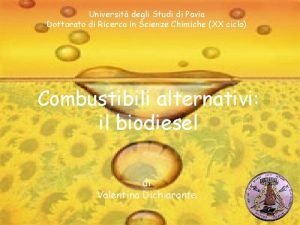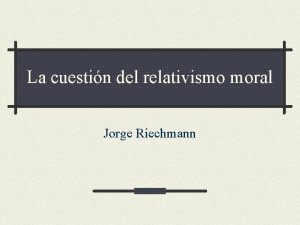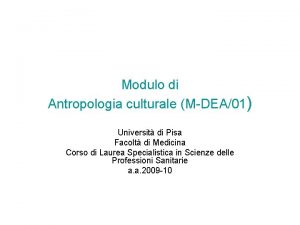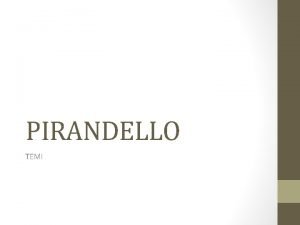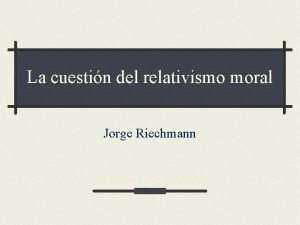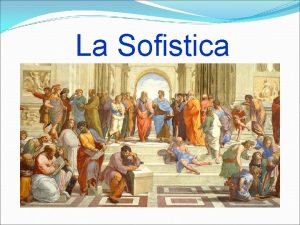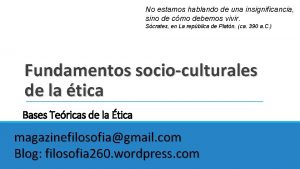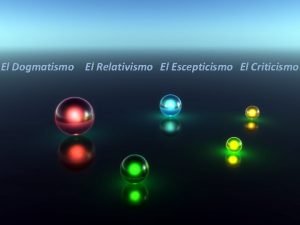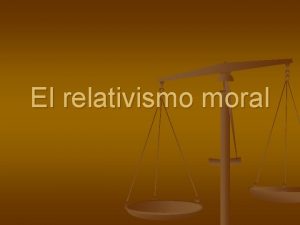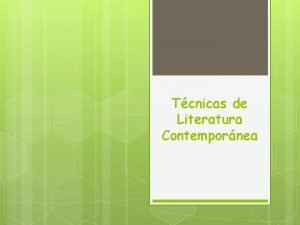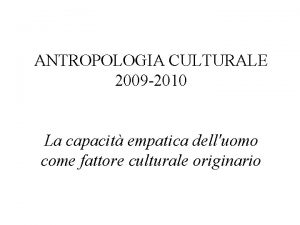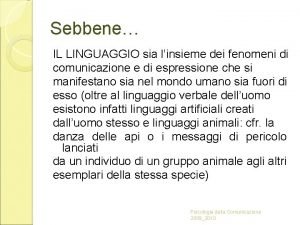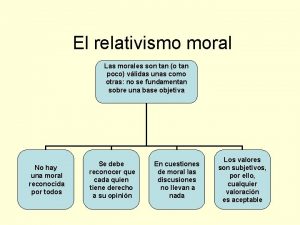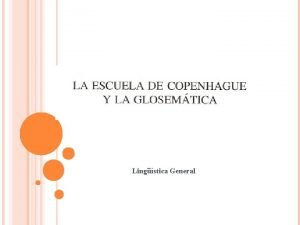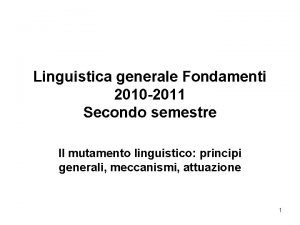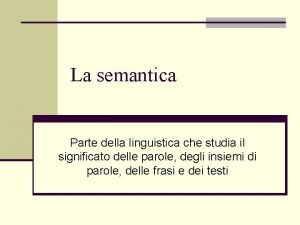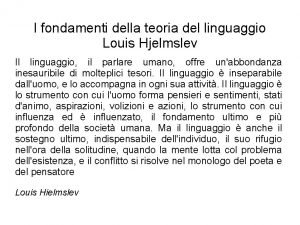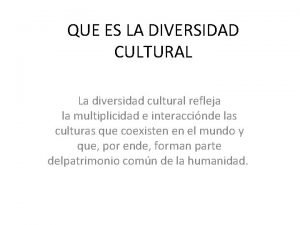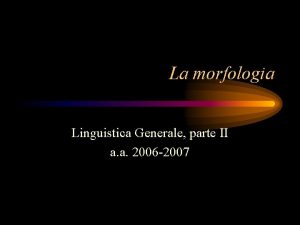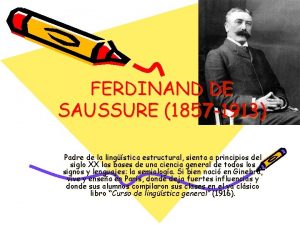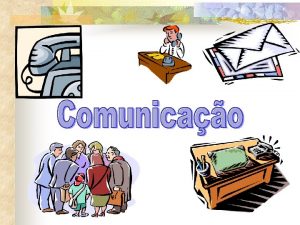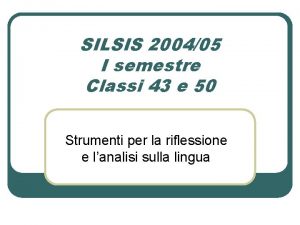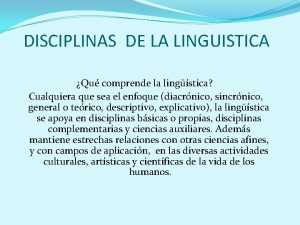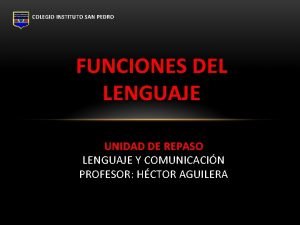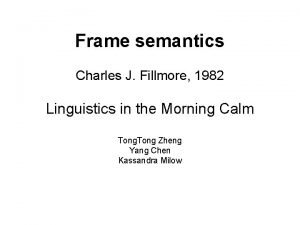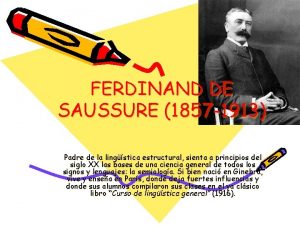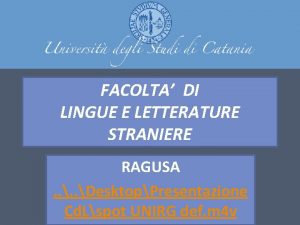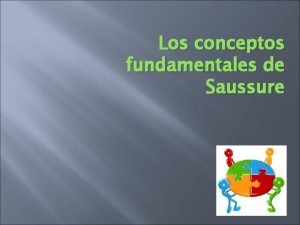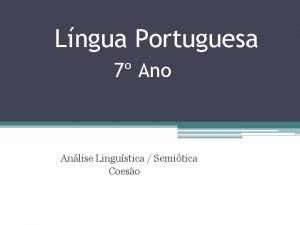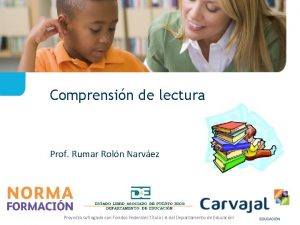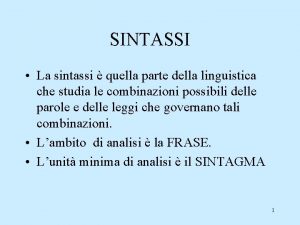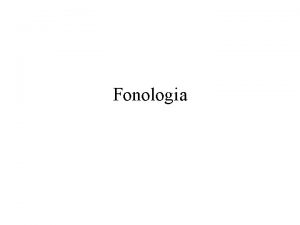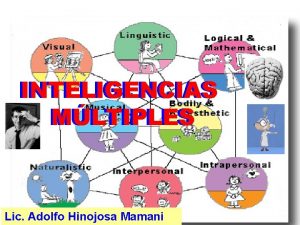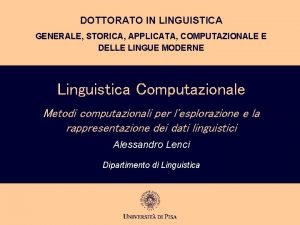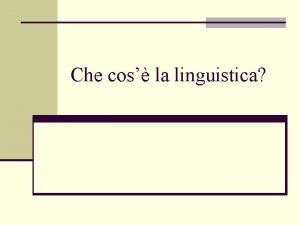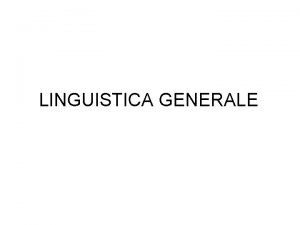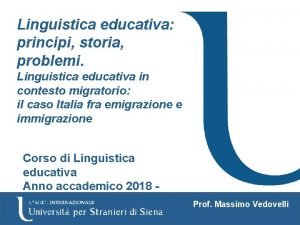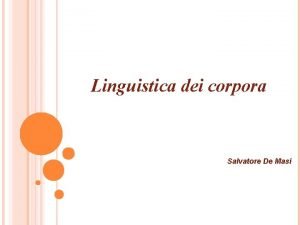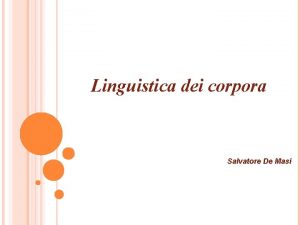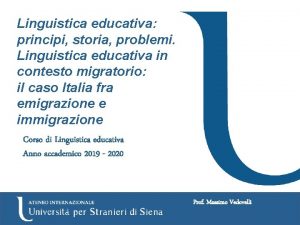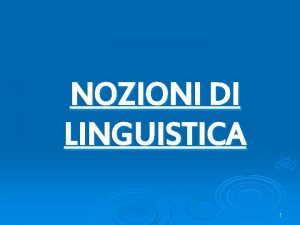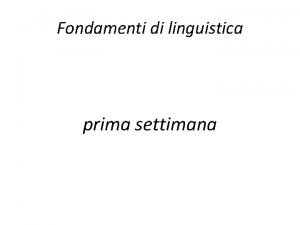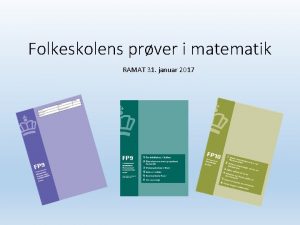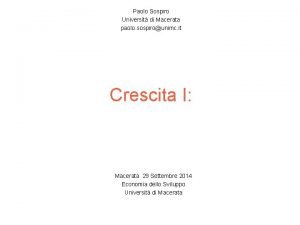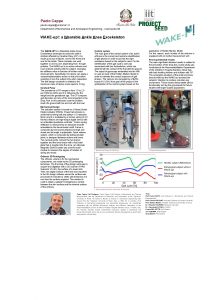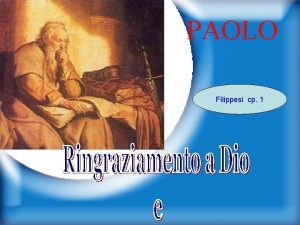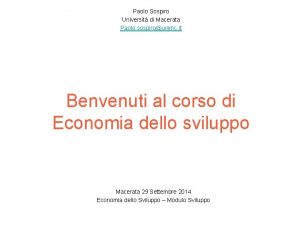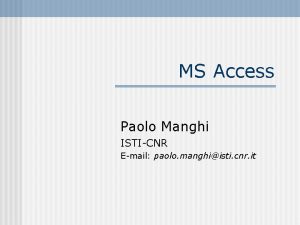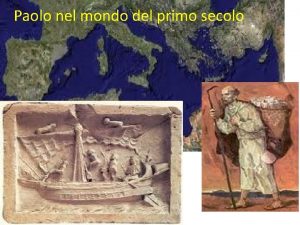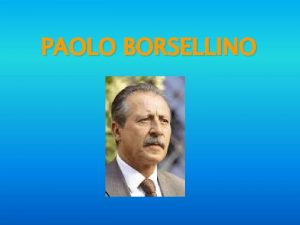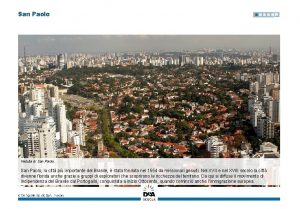Prof PAOLO RAMAT Dottorato in Linguistica 2011 Relativismo





![6. L’ipotesi ‘Sapir-Whorf’ • “La gramm. di ciascuna lingua[…]dà forma alle idee, è il 6. L’ipotesi ‘Sapir-Whorf’ • “La gramm. di ciascuna lingua[…]dà forma alle idee, è il](https://slidetodoc.com/presentation_image_h2/56aa98db3d15e3ade3f62ee94ea7f2ab/image-6.jpg)


































![41. Chomsky, Riassumendo. N. Ch p. 68 sg. ”Riassumendo, un contributo. , fondamentale [della] 41. Chomsky, Riassumendo. N. Ch p. 68 sg. ”Riassumendo, un contributo. , fondamentale [della]](https://slidetodoc.com/presentation_image_h2/56aa98db3d15e3ade3f62ee94ea7f2ab/image-41.jpg)

![[43. Gli sviluppi della teoria] [Though transformations continue to be important in Ch. 's [43. Gli sviluppi della teoria] [Though transformations continue to be important in Ch. 's](https://slidetodoc.com/presentation_image_h2/56aa98db3d15e3ade3f62ee94ea7f2ab/image-43.jpg)






- Slides: 49

Prof. PAOLO RAMAT, Dottorato in Linguistica 2011: “Relativismo e innatismo a confronto“ <<bil-maqlub tal-fdalijiet tal-mużew, l-ilsien huwa wirt ħaj, mitkellem u miktub ta’ kuljum filkomunikazzjoni>> “differently to artefacts found in a museum, the language is a living heritage, it is spoken and written everyday through communication” Strateġija Nazzjonali għall-Ilsien Malti (Bord għall-Ilsien Malti, 2001) , cit. in S. Caruana, Bilingualism and language policy in Malta

2. I testi: Edward Sapir, Il linguaggio. Introduzione alla linguistica. Trad. it. con presentaz. di Paolo Ramat. Torino, Einaudi 2007. Noam Chomsky, Linguistica cartesiana. Un capitolo di storia del pensiero razionalistico. Trad. it. in N. Chomsky, Saggi linguistici, vol. 3. Torino, Boringhieri 1969

3. I vantaggi di una lettura diretta di (parti di) testi significativi e le ragioni della scelta: I a) I due vol. fanno ormai parte della storia del pensiero linguistico e possono esser visti ‘a distanza’, con occhio storicocritico.

4. Le ragioni della scelta, II: b) Si tratta di due testi che, pur nati con finalità diverse, ben rappresentano due p. d. v. antitetici, tuttora discussi nel presente dibattito linguistico

5. Due biografie (vd. Wikipedia) • Edward Sapir 1884 -1939 • Noam Chomsky 1928 - ----
![6 Lipotesi SapirWhorf La gramm di ciascuna linguadà forma alle idee è il 6. L’ipotesi ‘Sapir-Whorf’ • “La gramm. di ciascuna lingua[…]dà forma alle idee, è il](https://slidetodoc.com/presentation_image_h2/56aa98db3d15e3ade3f62ee94ea7f2ab/image-6.jpg)
6. L’ipotesi ‘Sapir-Whorf’ • “La gramm. di ciascuna lingua[…]dà forma alle idee, è il programma e la guida dell’attività mentale […] Analizziamo la natura secondo linee tracciate dalle nostre lingue […] Siamo così indotti a un nuovo principio di relatività”, cit. da Mioni in Whorf, 1970: xiii

7. The Sapir-Whorf hypothesis (II) thoughts and behavior are determined (or are at least partially influenced) by language. ‘Strong version’: the language you speak determines the way that you will interpret the world around you; the weaker theory of linguistic relativism states that language merely influences your thoughts about the real world. From The Status of Linguistics as a Science(1929): ”Human beings do not live in the objective world alone [. . ], but are very much at the mercy of the particular language which has become the medium of expression in their society. It is quite an illusion to imagine that one adjusts to reality essentially without the use of language […]The fact of the matter is that the 'real world' is to a large extent unconsciously built up on the language habits of the group. The worlds in which different societies live are distinct worlds, not merely the same world with different labels attached. We see and hear and otherwise experience as we do because the language habits of our community predispose certain choices of interpretation. ”

8. I precedenti del relativismo • Edward Sapir studied the research of Wilhelm von Humboldt. About one hundred years before Sapir Humboldt wrote a strong version of linguistic determinism: "Man lives in the world about him principally, indeed exclusively, as language presents it to him. " Sapir took this idea and expanded on it. His writings state that there is clearly a connection between language and thought

9. I precedenti del relativismo: Wilhelm von Humboldt, I About one hundred years before Sapir Humb. wrote a strong version of linguistic determinism: ma “Die Gesetze des Denkens sind bei allen Nationen streng dieselbe, und die grammatischen Sprachformen können […] nur innerhalb eines gewissen Umfangs verschieden sein”, W. v. H. Über die Verschiedenheiten des menschlichen Sprachbaues (cfr. M. -E. Conte, Vettori del testo. Carocci 2010: 294 sg. [vd. riferim al # seg. ])

10. I preced. del relativismo: W. v. H. , II “Diversità fra le lingue significa per Humboldt diversità all’interno di una più alta unità”, M. -E. Conte, Vettori del testo, cit. , 296 (=trad. it. della recens. a Julia M. Penn, Linguistic Relativity versus Innate Ideas. Mouton 1972, in “Histor. Linguist. ” 2/1975)

11. The Sapir-Whorf Hypothesis (III) see Wikipedia, s. v. • Neither of them formally wrote the hypothesis nor supported it with empirical evidence, but through a thorough study of their writings about linguistics, researchers have found two main ideas. First, a theory of linguistic determinism that states that the language you speak determines the way that you will interpret the world around you. Second, a weaker theory of linguistic relativism that states that language merely influences your thoughts about the real world.

12. Problems with the Hypothesis According to the ‘strong version’ thought is not possible without language. What about the pre-linguistic thought of babies? How can babies acquire language without thought? Before language there would have been no thought. Another problem: languages and linguistic concepts are highly translatable. A final problem is Whorf's lack of empirical support for his linguistic insights.

13. La sostenibilità dell’ipotesi: I In 1954, Brown and Lenneberg tested how speakers of one language categorize the color spectrum and how it affects their recognition of those colors. “Englishspeaking subjects were better able to recognize those hues which are easily named in English. This finding is clearly in support of the limiting influence of linguistic categories on cognition". ". . . if codability of color affected recognizability, and if languages differed in codability, then recognizability is a function of the individual's language“.

14. La sostenibilità dell’ipot. : II • Lucy and Shweder's color memory test (1979) also supports the linguistic relativity hypothesis. If a language has terms for discriminating between color then actual discrimination/perception of those colors will be affected. Lucy and Shweder found that influences on color recognition memory is mediated exclusively by basic color terms –a language factor •

15. La sostenibilità dell’ipot. : III Kay and Kempton's language study (1984) found support for linguistic relativity. English speakers' perceptions were distorted in the blue-green area while speakers from Tarahumara–who lack a blue-green distinction–showed no distortion. • However, under certain conditions they found that universalism of color distinction can be recovered.

16. Il test dei colori Berlin and Kay's color study (1969) found universal focus colors and differences only in the boundaries of colors in the spectrum. Regardless of language or culture, eleven universal color foci emerge. Underlying apparent diversity in color vocabularies, these universal foci remain recognizable. Even in languages which do not discriminate to eleven basic colors, speakers are nonetheless able to sort color chips based on the eleven focus colors.

17. Conclusione: I • Greenberg came to the conclusion that "agreement in the fundamentals of human behavior among speakers of radically diverse languages far outweighs the idiosyncratic differences to be expected from a radical theory of linguistic relativity"

18. Conclusione, II • Culture influences the structure and functions of a group's language, which in turn influences the individual's interpretations of reality. Whorf saw language and culture as two inseparable sides of a single coin. Indeed, deciding which came first the language or the culture is impossible to discern. Schlesinger notes that Whorf recognized two directions of influence –from culture to language and vice versa. (1991: 17).

18. Commento al testo: 1 • Alla luce della preced. discussione passiamo ad esaminare alcune pagg. significative de Il linguaggio • Cap. I: Introd. : definiz. della lingua • Il camminare come ‘funzione biologica’ vs. il parlare come funzione acquisita, ’culturale’ contra vd. Lenneberg, I fondamenti biologici del linguaggio, 1967

20. Lenneberg, Biological Foundations of Language, 1967: I Lenn. pioneered the concept of innateness: "The Capacity of Language Acquisition" (1964) about the human-specific biological capacity for lg. : a) Universal appearance of a trait at a single time across a species. "Species typical" traits. b) Universal appearance across time for a group. Not just an artifact of cultural history. No learning of the trait is possible. c) Individual development of a trait rigidly follows a given schedule

21. Lenneberg, Biological Foundations of Language: II • In BFL (1967) he advanced the hypothesis of a critical period for language development; and also provided historical antecedents to issues such as embodied cognition

22. Commento al testo: 2 Pag. 8: “La lingua è un metodo puramente umano e non istintivo per comunicare idee, emozioni e desideri attraverso un sistema di simboli volontariam. prodotti” Per: definizione funzionalista della lingua

23. Commento al testo: 3 p. 15: “quanto a chi scrive, la sua profonda convinzione[…] è che l’impressione che molti hanno di poter pensare, o addirittura ragionare, senza lingua, sia un’illusione” Contra (cfr. supra in 12) Tomasello, Constructing a lg. A Usage-based theory of language acquisition 2003. He subscribes to the cognitive school of linguistic theory. He is a critic of Noam Chomsky's GG rejecting the idea of an innate UG and instead proposing a usage-based theory […] in which children learn linguistic structures through intention-reading and pattern-finding in their discourse interactions with others.

24. Commento al testo: 4 Un innatismo sfumato (I) p. 9: “Il linguaggio sfrutta organi e funzioni […] che sono giunti all’esistenza e sono normalmente usati per fini molto diversi da quelli linguistici” “exaptation” : a feature that performs a function but that was not produced by natural selection for its current use; Gould, S. J. , and E. S. Vrba. 1982. “Exaptation: A missing term in the science of form” Paleobiology 8(1): 4– 15.

25. Commento al testo: 5 • Un innatismo sfumato (II): p. 16 “questo processo di interazione fra lingua e pensiero si sta svolgendo sotto i nostri occhi. Lo strumento rende possibile il prodotto, e d’altra parte il prodotto porta a perfezionare lo strumento”

26. Commento al testo: 6 p. 20: “Dobbiamo quindi concludere che ogni comunicaz. volontaria di idee[…] è una trasposiz. , diretta o indiretta, del simbolismo tipico della lingua” p. 21: ”. . la lingua, come struttura, costituisce […]lo stampo del pensiero” p. 21 sull’universalità della lingua

27. Commento al testo: 7 p. 17: ”La lingua è primariamente un sistema uditivo di simboli” F. de Saussure e la semiotica. Saussure concepì la linguistica come parte di un più ampio studio dei segni, la semiologia; la lingua è un sistema di segni codificati, prodotto sociale della facoltà del linguaggio

28. Commento: 8. Processi grammaticali p. 59: ”ciascuna lingua possiede uno o più metodi formali[…] – P. 62: I vari processi grammaticali. Sei tipi principali: ordine delle parole; composiz. ; modificaz. del radicale; raddoppiam. ; differenze di accento” E’ l’abbozzo di una tipologia

29. Le relaz. sintatt. fondamentali p. 95 “Le relaz. sintatt. fondamentali debbono essere espresse in modo non ambiguo”: The farmer kills the duckling (: SVO) ‘Action prototypique’ avec AG+VB+PAT vs tonga, lingua ergativa: Na’e kai ‘e Sione ‘a e ika ASP manger ERG John OBJ-ABS ART poisson VB+AGERG+PAT (VSO) “Jean a mangé le poisson”, Lazard 1998: 64

30. Tipologia delle relaz. sintatt. Tre elementi astratti nella frase prototipica: X=AGent; Y=PATient, V=Verbo. Le relaz. sintatt. espresse astrattam. da un simbolismo valido per ogni lingua: p. es. X 0 Y 0 Vxy significa che le relaz. sintatt. sono espresse entrambe sul verbo e AG e PAT non recano nessuna marca. X 0 Vx Y 0 per The farmer kills the ducklings Vd. Lazard, “Pour une typol. des relations gramm. du verbe et des actants” LACITO 1979

31. Parola e frase: 1 p. 112 “…abbattendo la parete che separa la parola dalla frase, noi possiamo chiederci: […] quali sono i metodi fondamentali che servono a collegare parola a parola ed elemento a elemento, cioè […]a passare […] alla proposizione unitaria? ”

32. Parola e frase: 2 p. 120: ”Ogni lingua ha il suo schema. Tutto dipende dalle demarcazioni formali riconosciute da ciascuna lingua” Relativismo assoluto

33. La lingua come prodotto storico: la deriva p. 151: “La lingua si muove, scende lungo il corso del tempo seguendo una corrente che essa stessa crea”. P. 155: ”La deriva linguist. […]ha una direzione”. P. 172: ”questa deriva ha una sicura e costante direz. ”: Teleologismo della ‘deriva’ (drift) ? . Vd. Ramat, Presentaz. , xv-xvi.

34. La linguist. cartesiana di Chomsky (1966) Da una tradiz. che risale anche a prima dei cartesiani, N. Ch. riprende interessi per il linguaggio proprii del ‘ 600 e del ‘ 700. p. 44: ”non cercherò di caratterizzare la ling. cart. così come essa si considerava, ma mi concentrerò piuttosto sullo sviluppo di concetti che sono riaffiorati[…] in opere contemp. ”

35. Cartesio Discorso sul metodo (1637): “. . gli uomini, che nati sordi e muti, privi degli organi che servono agli altri per parlare, sogliono inventare da sé alcuni segni con cui si fanno intendere”. ----N. Ch. , p. 47: “In breve, dunque, l’uomo ha una capacità specifica della specie[…]che non può essere[…] correlata con l’intelligenza in generale, e che si manifesta in quello che può essere chiamato l’ ‘aspetto creativo’ del comune uso linguistico […]la cui proprietà consiste […]nell’ indipendenza da stimoli”. Cfr. Lenneberg, BFL, supra, # 20, 21

34. Cordemoy, Discours physique de la parole (1666) Rapporto di necessità tra linguaggio e realtà: ”la funzione significativa […]non potrà avere[…]i connotati di libera creatività uma na, come vuole intendere Chomsky, in quanto i rapporti […]tra segni sonori e con-tenuti mentali sono rapporti tra sostanze date [cioè res extensa] e contenuti mentali [res cogitans] e non tra forme assunte arbitrariamente dalle facoltà intellettuali e fantastiche dell’ uomo”, Rosiello, Linguist. illumin. 1967: 113 sg.

37. La creatività linguist. N. Ch. p. 57 “Nel periodo romantico permane un interesse per l’aspetto creativo dell’uso linguist. ”: dall’innatismo universalistico cartesiano al relativismo romantico –ma Ch. ignora l’empirismo sensista illuminista basato sull’ aristotelico nihil est in intellectu quin prius fuerit in sensu. Vico: “i sensi sieno le sole vie ond’ella [scil. la natura umana] conosca le cose; Condillac, Traité des sensations (1754). Vd. Rosiello, Linguist. illum. : Bologna 1967: 71

38. Humboldt in Chomsky Un errore di prospettiva storica: N. Ch. riconosce nella distinz. di Humb. tra ‘forma interna’ e ‘forma esterna’ un antecedente delle sue ‘struttura profonda’ e ‘struttura superf. ’ Ma ‘forma int. ’ per Humb. significa uno schema kantiano trascendentale di co(no)scienza della realtà mentale, non le idee innate di Cartesio. Cfr. Rosiello, Linguist. illum. 187.

39. Humboldt e Chomsky N. Ch. , p. 64: ”la forma linguist. di Humb. condiziona tutti gli atti individuali di produz. o percez. vocale in una lingua determinata e […] gli aspetti universali della forma grammaticale determinano la classe delle lingue possibili” N. Ch. : Gramm. Univers. N. Ch. , nota 46: ”Il titolo dell’opera principale di Humb. non deve far supporre che egli sia favorevole all’opinione che ciascuna lingua sia un prodotto storico unico [contra] la tradiz. ‘boasiana’ [>Sapir] “che le lingue potrebbero differire tra loro senza limiti”

40. Humboldt, Schlegel e Chomsky In Humb. si riflette l’irrisolta questione alla base di questo corso: innatismo razionalistico ~ relativismo storico. La differenza delle lingue si inquadra all’interno dell’idea di ‘lingua’ A. W. Schlegel (Lettere, 1822)[cit. in N. Ch. , nota 46]: ”E’ innegabile che tutte le lingue, rispetto alla grammatica, si rassomigliano molto, se le analizziamo non superficialm. , ma profondam. Nel loro interno” N. Ch. : Gramm. Univers.
![41 Chomsky Riassumendo N Ch p 68 sg Riassumendo un contributo fondamentale della 41. Chomsky, Riassumendo. N. Ch p. 68 sg. ”Riassumendo, un contributo. , fondamentale [della]](https://slidetodoc.com/presentation_image_h2/56aa98db3d15e3ade3f62ee94ea7f2ab/image-41.jpg)
41. Chomsky, Riassumendo. N. Ch p. 68 sg. ”Riassumendo, un contributo. , fondamentale [della] ‘linguist. cartesiana’ consiste nell’osservaz. che il linguaggio umano […] non subisce il controllo di stimoli esterni o di stati interni identificabili in modo indipendente e […] non è circoscritto a una funzione comunicativa pratica” [c. vo mio: antifunzionalismo]

42. Struttura Profonda e Struttura Superficiale La ‘linguist. cartes. ’ distingue un aspetto interno e uno esterno. “Usando una terminologia recente possiamo distinguere la ‘SP’ di una frase dalla sua ‘SS’”: p. 72 La SP rappresenta “the core semantic relations of a sentence, mapped on the SS, via transformations”. La SP possiede proprietà comuni a tutte le lingue
![43 Gli sviluppi della teoria Though transformations continue to be important in Ch s [43. Gli sviluppi della teoria] [Though transformations continue to be important in Ch. 's](https://slidetodoc.com/presentation_image_h2/56aa98db3d15e3ade3f62ee94ea7f2ab/image-43.jpg)
[43. Gli sviluppi della teoria] [Though transformations continue to be important in Ch. 's current theories, he has now abandoned the original notion of DS and SS. Initially, two additional levels of representation were introduced (LF — Logical Form, and PF — Phonetic Form), and in the 1990 s Ch. sketched out a new program of research known as Minimalism, in which DS and SS no longer featured and PF and LF remained as the only levels of representation. Ma per i fini del corso è utile rifarsi alla prima versione: vd. # 44]

44. Port-Royal e Chomsky N. Ch. , p. 79: ”Riassumendo la teoria di Port-Royal nei suoi tratti generali, una frase ha un aspetto mentale interno (una SP portatrice del significato) e un aspetto fisico esterno considerato come sequenza di suoni […]. P. 80: ”In termini moderni, possiamo formalizzare questa concez. descrivendo la sintassi in termini di due sistemi di regole: un sistema di base che genera SP e un sistema trasformazionale che le applica in strutture superficiali. ”

45. Universali linguist. e gramm. generale competenza linguist. N. Ch. , p. 97: ”Ci sono[…]certi universali linguist. che pongono limiti alla varietà del linguaggio umano. Lo studio delle condiz. universali che prescrivono la forma di qualsiasi lingua umana è la ‘grammatica generale’. Tali condiz. univers. non vengono imparate; esse forniscono […] i principi organizzativi[…]; attribuendo tali principi allo spirito, quale proprietà innata, diventa possibile spiegare […] che il parlante[…] conosce molte cose che non ha imparato - competenza linguistica innata

46. La competenza linguist. innata N. Ch. , p. 98 “ci sono alcuni ‘principi o nozioni insiti nello spirito[…] un dono della Natura, un precetto dell’istinto naturale’”, citaz. da Herbert of Cherbury, De veritate (1624)

47. Cartes. Linguist. : conclusione N. Ch. , p. 108: ”. . nella percez. non funziona semplicem. un deposito di schemi, ma piuttosto un sistema di regole fisse per generare tali schemi. Anche sotto questo aspetto, sarebbe esatto definire le attuali [1966] ricerche come una continuaz. della tradiz. linguist. cartes. e della psicologia che ne è alla base. ”

48. Una sintesi: 1 Drawing together a vast body of research of empirical research in cognitive science, linguistics, and developmental psychology, M. Tomasello (Constructing a Language. A Usage-Based Theory of Language Acquisition, Harvard UP 2003) demonstrates that we don’t need a selfcontained ‘language instinct’ to explain how children learn lg. Their linguistic ability is intervowen with other cognitive abilities

49. Una sintesi: 2 Tomasello argues that the essence of lg. is in its symbolic dimension, which rests on the uniquely human ability to comprehend intention. Grammar emerges as the speakers create linguistic constructions out of recurring sequences of symbols: children pick up these patterns in the buzz of words they hear around them. The theory contrasts to nativist or ‘UG’ theories such as those of Chomsky and Pinker, The lg. instinct: How the mind creates lg. , New. York 1994
 Anna giacalone ramat
Anna giacalone ramat Locomotia in mediul terestru
Locomotia in mediul terestru Scheletul capului
Scheletul capului Prof paolo bellioni
Prof paolo bellioni Prof. paolo sequi
Prof. paolo sequi Dottorato
Dottorato Iuav scuola di dottorato
Iuav scuola di dottorato Dottorato di ricerca bologna
Dottorato di ricerca bologna Dottorato di ricerca pavia
Dottorato di ricerca pavia Relativismo moral
Relativismo moral Antropologia pisa
Antropologia pisa Surgimento dos sofistas
Surgimento dos sofistas Visione di pirandello
Visione di pirandello Relativismo moral
Relativismo moral Sofistica filosofia
Sofistica filosofia Que es el relativismo
Que es el relativismo Dogmatismo escepticismo y relativismo
Dogmatismo escepticismo y relativismo Relativismo moral
Relativismo moral Corriente de la conciencia
Corriente de la conciencia Relativismo culturale
Relativismo culturale Pensiero pirandello
Pensiero pirandello Relativismo
Relativismo Relativismo moral
Relativismo moral Prueba de conmutación linguistica
Prueba de conmutación linguistica Fonologizzazione esempi
Fonologizzazione esempi Emisor receptor mensaje código canal y contexto ejemplos
Emisor receptor mensaje código canal y contexto ejemplos Semantica componenziale
Semantica componenziale Louis trolle hjelmslev
Louis trolle hjelmslev Inteligencia naturalista personajes
Inteligencia naturalista personajes Concepto de diversidad lingüística
Concepto de diversidad lingüística Composti dvandva
Composti dvandva Padre de la linguistica estructural
Padre de la linguistica estructural Traduzi
Traduzi Sintagmi nominali
Sintagmi nominali Disciplinas de la linguistica
Disciplinas de la linguistica Que es la funcion linguistica
Que es la funcion linguistica Paraverbales
Paraverbales Fillmore 1982
Fillmore 1982 Rotacizzazione linguistica
Rotacizzazione linguistica Linguagem formal
Linguagem formal Ferdinand de saussure (1857-1913)
Ferdinand de saussure (1857-1913) Lingue ragusa
Lingue ragusa Familia
Familia Saussureano
Saussureano O que é coesão referencial
O que é coesão referencial Ramas de la lingüística
Ramas de la lingüística Parte della sintassi
Parte della sintassi Coppie minime di parole
Coppie minime di parole Inteligencia linguistica verbal actividades
Inteligencia linguistica verbal actividades Conclusión de la diversidad lingüística
Conclusión de la diversidad lingüística
